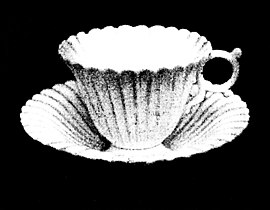duced cost. The bold ornamentation of their jardinières, umbrella-jars, punch-bowls, and vases, after the Doulton, Royal Worcester, and Adderley methods, bears a striking individuality of its own. Probably their most beautiful pieces are those on which raised gold designs are applied by hand to an exquisite mazarine blue. White tiles of the finest quality, with underglaze blue
 Fig. 24.—Egg-shell Porcelain—The "Engagement" Cup and Saucer. Ceramic Art Company. printed devices, as well as embossed and art tiles, are also made to some extent. The Greenwood Pottery Company, incorporated in Trenton in 1868, make a specialty of the manufacture of vitrified and translucent china for hotel, steamship, and railway uses. This pottery was established in 1861, under the style of Stephens, Tams & Co. They are also making, at the present time, thin china table ware for domestic purposes, porcelain hardware trimmings, and electrical, telegraph, and telephone insulating supplies. Some years ago they added an art department
Fig. 24.—Egg-shell Porcelain—The "Engagement" Cup and Saucer. Ceramic Art Company. printed devices, as well as embossed and art tiles, are also made to some extent. The Greenwood Pottery Company, incorporated in Trenton in 1868, make a specialty of the manufacture of vitrified and translucent china for hotel, steamship, and railway uses. This pottery was established in 1861, under the style of Stephens, Tams & Co. They are also making, at the present time, thin china table ware for domestic purposes, porcelain hardware trimmings, and electrical, telegraph, and telephone insulating supplies. Some years ago they added an art department  Fig. 25.—White-ware Pitcher. Phœnixville, Pa. to their extensive establishment, and their decorated productions are characterized by elegance of form, being decorated usually in the Royal Worcester style, with ivory finish and raised gold, silver, and bronze effects. The plant of the company consists of seventeen large kilns, with an annual producing capacity of over half a million dollars.
Fig. 25.—White-ware Pitcher. Phœnixville, Pa. to their extensive establishment, and their decorated productions are characterized by elegance of form, being decorated usually in the Royal Worcester style, with ivory finish and raised gold, silver, and bronze effects. The plant of the company consists of seventeen large kilns, with an annual producing capacity of over half a million dollars.
Among the other important Trenton establishments is that of Messrs. Oliphant & Co., which turns out large quantities of plumbers' sanitary appliances, druggists' and jewelers' supplies. About 1886 the late Mr. Thomas Connolly, a partner in the concern, commenced experimenting in Belleek wares, having been at one time connected with the Irish works. He succeeded in producing some exquisitely thin trial pieces, and demonstrated the fact that these works could manufacture egg-shell ware of the highest grade. The few pieces which were produced, consisting
